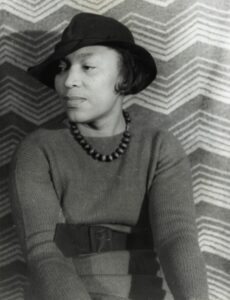Celebrating Black History Month: A Profile of Author and Humanist Zora Neale Hurston
 Zora Neale Hurston photographed by Carl Van Vechten, 1938 (via Library of Congress)
Zora Neale Hurston photographed by Carl Van Vechten, 1938 (via Library of Congress) This profile was first published in the March/April 2012 issue of the Humanist magazine.
Why fear? The stuff of my being is matter, ever changing, ever moving, but never lost; so what need of denominations and creeds to deny myself the comfort of all my fellow men? The wide belt of the universe has no need for finger-rings. I am one with the infinite and need no other assurance.
—Zora Neale Hurston, from her 1942 autobiography, Dust Tracks on a Road
Zora Neale Hurston was born on January 7, 1891, in Notasulga, Alabama, the fifth of eight children. Her father was a Baptist preacher and farmer and her mother was a teacher. When Zora was three the family moved to Eatonville, Florida, the first incorporated all-black township in the United States, where her father later became the mayor. Her happy childhood in Eatonville, remembered in stories she wrote later as a place where blacks were independent, successful, and culturally affirmed, may have contributed to her opposition later on to integration, chiefly the Brown v. Board of Education decision in 1954.
Hurston’s mother died when Zora was thirteen. Her father quickly remarried, and Zora was sent to boarding school. After a time he stopped paying her tuition and she was expelled. She worked as a maid in a traveling theatrical company, and then, in 1917, the twenty-six-year-old lied about her age to gain admission to the Morgan Academy, graduating from the high school the following year.
Hurston attended Howard University and in 1927 graduated from Barnard College with a BA in anthropology, followed by two years as a graduate student at Columbia. In New York she became a prominent member of the Harlem Renaissance. The engaging and gregarious Hurston, together with Langston Hughes and other writers, formed what they called close-knit group and published the literary magazine, Fire!!, in 1926.
Starting in 1928, Hurston’s anthropological research was funded by philanthropist and socialite Charlotte Osgood Mason. Hurston traveled to the American South and the Caribbean, developing a talent for dialects that would appear in her stories and which was further honed in later travels to Jamaica and Haiti to study African rituals.
Hurston’s critically acclaimed study of African-American folklore, Mules and Men, was published in 1935. She also published three novels in the 1930s: Jonah’s Gourd Vine, Their Eyes Were Watching God (her most famous work, written when she was in Haiti), and Moses, Man of the Mountain. In all she published four novels, two books of folklore, an autobiography, several plays, and numerous short stories, essays, and articles. She also married twice, but neither marriage lasted very long. She did not have children.
Hurston’s literary star had faded by the 1950s. It’s said that the folklorist bent of her work and use of African-American dialect was seen as something like caricature that pandered to white readers and disempowered blacks.
Hurston suffered a stroke in 1959 and had to enter a county welfare home in Florida, where she’d moved around 1950. She died penniless in 1960—the cause listed as hypertensive heart disease—and was buried in an unmarked grave in a cemetery at nearby Fort Pierce.
In 1973, writer and Hurston fan Alice Walker located Hurston’s grave and had a headstone installed. Walker’s Ms. magazine article, “In Search of Zora Neale Hurston,” published two years later, launched a renewed interest in Hurston’s work; a number of story collections were published posthumously, several documentaries about her life have been made, and Eatonville holds an annual festival in her name.
A strong feminist, Hurston was also very skeptical about organized religion, referring to its creeds as “collections of words around a wish.” She wrote in her autobiography, “I feel no need for such. However, I would not, by word or deed, attempt to deprive another of the consolation it affords. It is simply not for me. Somebody else may have my rapturous glance at the archangels. The springing of the yellow line of morning out of the misty deep of dawn, is glory enough for me.”
